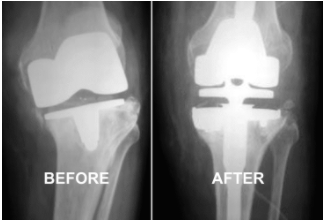Revision Knee Replacement Surgery
What is Revision Knee Replacement Surgery?
Revision Knee Replacement means that part or all of your previous knee replacement needs to be revised.
This operation varies from very minor adjustments to massive operations replacing significant amounts of bone.
The typical knee replacement replaces the ends of the femur (thigh bone) and tibia (shin bone) with plastic inserted between them and usually the patella (knee cap).
Why Consider a Revision Knee Replacement Surgery?
Pain is the primary reason for revision. Usually, the cause is clear but not always. Knees without an obvious cause for pain, in general, do not do as well after surgery.
- Plastic (polyethylene) wear - This is one of the easier revisions where only the plastic insert is changed.
- Instability - This means the knee is not stable and may be giving way or not feel safe when you walk.
- Loosening of either the femoral, tibial or patella component - This usually presents as pain but may be asymptomatic. It is for this reason why you must have your joint followed up for life as there can be changes on X-ray that indicate that the knee should be revised despite having no symptoms.
- Infection - usually presents as pain but may present as swelling or an acute fever.
- Osteolysis (bone loss) - This can occur due to particles being released into the knee joint that results in bone being destroyed.
- Stiffness - This is difficult to improve with revision but can help in the right indications.
- Joint Wear- After partial knee replacement osteoarthritis may have advanced to other compartments of the knee.
- Fractures- Although rare, trauma to the knee may result in a fracture that disrupts the stability of the implant and fixation to the bone which may require surgery to repair.



